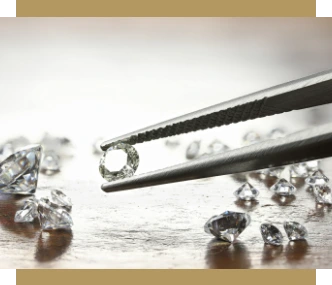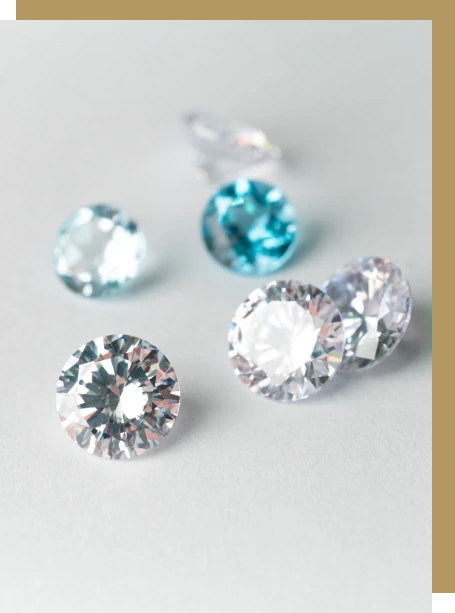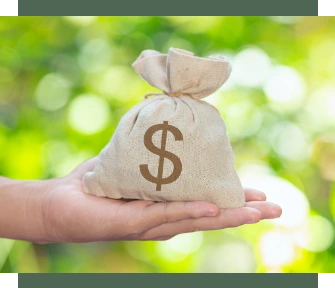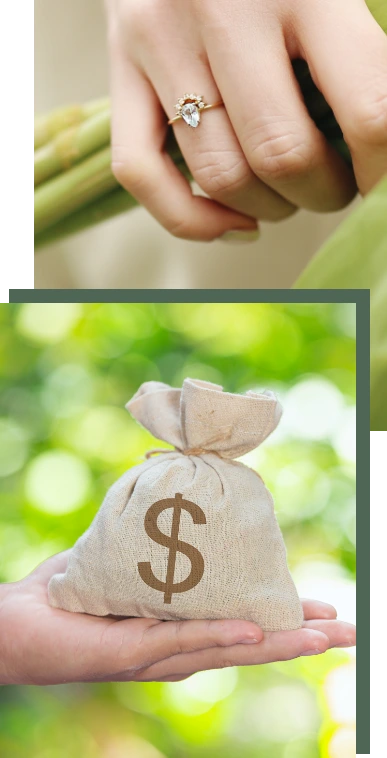
Learn About The 4C's -
Understanding Diamond Grading
The 4C's of Diamonds: Carat, Cut, Color, and Clarity
The 4C’s represent the key visual aspects of a diamond, consisting of Carat, Cut, Color, and Clarity. These four features are graded and categorized to identify the diamond’s size and quality, differentiate between similar diamonds, and establish the diamond’s value and price. The Gemological Institute of America (GIA) establishes the grading scales for the 4C’s, ensuring standardized practices for consumers and gemologists to accurately identify diamonds. By mastering the 4C’s, you’ll be well-equipped to select a diamond within your budget, maximizing both quality and size. This guide provides an essential introduction to the 4C’s, helping you understand what to look for and how to evaluate a diamond’s quality and value.


Selecting the Ideal Diamond
Every diamond, whether natural or lab-created, is graded on quality using a universal system that assesses the stone based on its color, clarity, cut, and carat-weight; this is commonly referred to as the 4C’s of diamonds. This grading system only applies to diamonds and not to diamond simulants such as cubic zirconia or moissanite. Each Diamond Lab diamond, regardless of its size, possesses a unique set of characteristics and standards that define its value and trace its journey to your jewelry piece. Every Diamond Lab diamond is certified only by reputable Gemological Laboratories like GIA, IGI and HRD.


Though not one of the 4C's, the diamond's shape, along with its carat size, is a highly personal aspect of the selection process. The diamond shape reflects individual preferences and style. Round brilliant is the most popular shape for engagement rings, offering the highest level of sparkle and brilliance among all diamond shapes and providing a softer appearance on your finger. The princess cut, the second most popular shape, lends a more architectural feel to your ring. Your choice of diamond shape may vary based on personal taste, budget, jewelry style, diamond quality, and other factors. Other diamond shapes include pear, oval, emerald, and cushion cuts.


Diamond carat represents its weight and determines the diamond's size. The larger the diamond, the rarer and more valuable it becomes. Carat is the most obvious of the 4C's. Not to be confused with karat (a measure of gold purity), 1.00 carat (ct) diamond weighs 0.20 grams. Diamond size is measured in millimeters, considering both length and width, or simply the diamond's diameter. Producing a 1.00ct diamond typically requires mining around 250 tons of rock, which is why diamonds are rare and costly.
Diamonds in each carat range have average millimeter sizes, providing an approximation of their visual size. Though each diamond is unique, these millimeter measurements are generally standard, especially since modern diamonds are cut using machines for precision. To accurately gauge a diamond's size, assess its measurements. Well-cut round diamonds tend to have less depth compared to well-cut fancy-shaped diamonds (shapes other than round).
Pro tip: Opting for a slightly smaller carat weight (such as 0.99 cw vs 1.00 cw) can lead to significant savings, as diamond prices typically increase with each quarter step.


The cut of a diamond goes beyond merely describing its shape; it determines the diamond's ability to capture and refract light, giving it its unique sparkle. Diamonds with exceptional cuts exhibit incredible brilliance, fire, and desirability, while poorly-cut diamonds can seem lifeless and dark, even if they possess high color or clarity grades.
The remarkable radiance of well-cut diamonds often creates the illusion of a larger size compared to other diamonds with the same carat weight. Ideal diamonds boast higher levels of brilliance and diameter relative to diamonds with deeper cuts.
Of the 4C's, the cut is frequently regarded as the most crucial attribute, as it significantly influences the diamond's overall appearance and quality. Experts in the field often advise prioritizing the diamond's cut above all other factors.


Color, the third of the 4C's, actually refers to the absence of color in diamonds. The color of a diamond is graded on an alphabetical scale that starts at D and extends to Z. D represents a colorless diamond, while Z indicates a yellow diamond. The presence of yellow in a diamond can absorb sunlight and reduce the stone's light refraction and sparkle.


During the formation of diamonds, microscopic impurities or imperfections can become embedded within the diamond. These imperfections, known as diamond inclusions, are quite common and essentially serve as birthmarks that make every diamond unique. The accumulation of inclusions contributes to a diamond's clarity, which is assessed by gemologists and graded on a scale ranging from FL to I3. Inclusions are examined at 10x magnification.
Beyond the C's
The term “carat” has ancient roots, with a history of weighing precious metals and stones against the seeds of the carob tree, believed to be uniform in weight. It was not until 1907, at the Fourth General Conference on Weights and Measures, that one diamond carat was standardized as equivalent to 200 mg or 0.2 grams of a diamond. Furthermore, carats can also be measured in points, where a full carat equals 100 points.


Fluorescence
Diamond fluorescence refers to the intensity of a colored glow (usually blue) that becomes visible when a diamond is exposed to UV light. In certain cases, diamonds with strong fluorescence may appear milky or hazy in daylight. However, in most instances, the appearance of a diamond with strong fluorescence is barely affected. Diamonds with no or faint fluorescence are rarer than those with strong or very strong fluorescence. Diamonds with fluorescence can be considered advantageous, as they are priced slightly lower in the market, allowing you to get a better deal. If you are unsure whether fluorescence will impact the diamond you’ve chosen, we recommend contacting us for assistance.

Diamond Pricing
Grasping the factors that impact price and their implications is crucial in making an informed decision about the right trade-offs for your budget, setting your personal levels of compromise within the scales. The array of diamond options might initially seem daunting, and although there are numerous additional specifications to consider, the choices don’t have to be bewildering. Keep in mind that, ultimately, you are investing in an item of significant value that can be passed down for generations to come. Comprehending the factors that influence price and their real-world implications is essential, allowing you to make the best-informed decision regarding the right balance for your budget and determining your own levels of compromise within the scales. While the variety of diamonds may seem overwhelming at first glance, and there are many more specifications to take into account, the choices need not be confusing. Remember, you are ultimately purchasing an item that holds tremendous value and can be passed down through generations.
Comprehending the factors that influence price and their real-world implications is essential, allowing you to make the best-informed decision regarding the right balance for your budget and determining your own levels of compromise within the scales. While the variety of diamonds may seem overwhelming at first glance, and there are many more specifications to take into account, the choices need not be confusing. Remember, you are ultimately purchasing an item that holds tremendous value and can be passed down through generations. Advice: Avoid purchasing a diamond solely as a financial investment. Instead, consider it a sentimental investment.

Advice: Avoid purchasing a diamond solely as a financial investment. Instead, consider it a sentimental investment.
A few reasons to support this argument are:
- Market fluctuations: The value of diamonds can be subject to market fluctuations, making it a less reliable investment compared to other options such as stocks or real estate.
- Emotional value: Diamonds are often associated with significant life events like engagements, weddings, and anniversaries. Purchasing a diamond for a romantic partner strengthens emotional bonds and creates lasting memories, making it a more valuable sentimental investment.
- Resale value: Although diamonds retain a certain degree of value over time, the resale market for diamonds can be challenging. Finding a buyer who is willing to pay a fair price for your diamond may be difficult, and you might not recoup the full amount you initially spent.
- Rarity: While diamonds are often marketed as rare and valuable, they are not the rarest gemstones available. Additionally, the diamond market is heavily influenced by industry practices, which can affect the perceived value of a diamond.